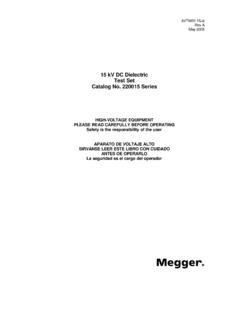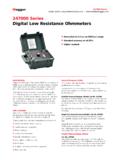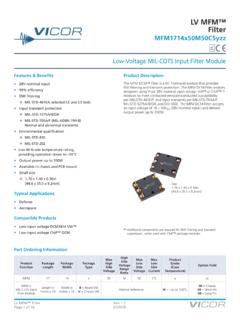Transcription of T1 OVERVIEW THE HIGH-CAPACITY DIGITAL NETWORK
1 T1 OVERVIEW . THE HIGH-CAPACITY . DIGITAL NETWORK . MeterCenter (800) 230-6008. (480) 659-8351 Outside USAeteM. TABLE OF CONTENTS. THE HIGH-CAPACITY DIGITAL NETWORK ..2. T1 Service ..2. Customer Benefits ..2. Technology Review ..2. T1 Architecture ..8. T1 Equipment Function ..9. Customer Service Unit (CSU) ..9. Demarcation Point ..9. NETWORK Interface Device (NID) ..10. Station Wire Color Code ..10. NETWORK Interface Unit (NIU) ..11. Main Distribution Frame (MDF) ..11. Office Repeater ..11. DIGITAL Signal Cross-Connect (DSX).
2 13. Testing and Troubleshooting T1 Networks ..14. Performance Parameters ..14. Stress Patterns ..15. Alarm and Status Conditions ..15. Common Tests Performed With the 20T1 Test Set ..17. 20T1 Modes of Operation ..17. Performing Automatic Evaluation ..18. Monitoring Live Traffic ..19. Performing a BERT (Bit Error Rate Test) ..20. Performing Clock-Slip Measurements ..21. Performing a Half Duplex Drop & Insert ..22. Performing a Loop Delay Measurement on a T1 Circuit ..22. Performing a Bridge Tap (BTP) or Multi-pattern (MPT) Test on a T1 Circuit.
3 23. BTP ..23. MPT ..23. T1 GUIDE THE high capacity DIGITAL NETWORK 1. THE HIGH-CAPACITY DIGITAL NETWORK Connect cellular sites HIGH-CAPACITY , DIGITAL Signal Level 1 (DS1 Hi-Cap) service, also Interexchange Carrier (IC). known as T1, is just one type of Hi-Cap service available to telephony customers. There is a higher order, or hierarchy, of Note: The PRI circuit requires special dial-though testing not T1 such as DS2, also known as T2, or DS3, also known as T3, associated with a point-to-point T1. that also may be ordered.
4 However, the focus of this Customer Benefits document is on T1 service. Some of the drivers behind the demand for T1 service are: T1 is a high speed NETWORK developed by AT&T in 1957 and implemented in the early 1960s. The technology was Flexibility developed to support long-haul pulse-code modulation (PCM) T1 handles voice and/or data services. voice transmission. The innovation of T1 was to introduce Bandwidth can be allocated on demand. digitized voice and to create a communication link that Improved quality over analog lines.
5 Enables transmission of voice, data and video signals at the Increased capacity over conventional lines: rate of million bits per second (Mb/s). The telephone 1-24 standard voice/data channels (DS0s). companies initially used T1 to reduce the number of Guaranteed Service telephone cables in a large metropolitan area. A DS1 Hi-Cap, Most carriers strive to offer restoration in less than 3 hrs. or T1, is: Available percent annually. A point-to-point service. In the past decade, costs have been reduced from tens of Mbps DIGITAL pipe Transport Technology thousands of dollars per month to around $500 per month and installation times (customer due dates) have gone from The T1 may be provided using fiber optic transport devices or several weeks to same-day service.
6 Copper cable facilities. Technology Review T1 Service A vast majority of T1 benefits are attributed to the fact that Due to installation costs, early T1 services were used primarily voice and data share a single DIGITAL communication link. by phone companies and the federal government. Customers, Computer data consists of 1's and 0's, the symbols of the binary particularly those not requiring all of the bandwidth available system; therefore computer data is already compatible with T1's on a T1 circuit, would have needed to purchase expensive DIGITAL format.
7 Voice presents another challenge. Voice signals multiplexing equipment not required for analog transmission. actually comprise of complex analog waveforms. The cost of multiplexing equipment, plus the fact that service charges were still based on the amount of bandwidth Sine waves are all we have to work with in transmitting over purchased, did not make T1 an economic decision for many the analog telephone channel because it doesn't transmit potential customers. T1 was re-tariffed in the early 1980s to pulses. DIGITAL transmission systems will transmit pulses, and allow substantial cost savings to customers who had multiple with them we can encode either analog or DIGITAL information circuits between two locations.
8 With customer requirements by modulating pulses. There are a few ways to modulate a for interlocation connectivity, growth rates have continued to series of pulses to carry data. climb for services such as: Internet Service Provider (ISP) access ISDN Primary Rate Interface (ISDN PRI) access Carrier Facilities Channel Service for multiple applications Local Area NETWORK /Wide Area NETWORK Customer Premise Central Office Customer Premise Equipment (CPE) Equipment (CPE). (LAN/WAN) connectivity for data transfer and sharing Medical data transfer ( , X ray, CAT scan).
9 Mainframe computer links Videoconferencing Customer Location A Customer Location Z. Private Branch Exchange (PBX) connectivity Figure 1: DS1 Hi-Cap, T1. 2 T1 GUIDE THE high capacity DIGITAL NETWORK . When the amplitude of the pulses is varied to represent analog information, the method is called pulse amplitude modulation (PAM). This method is very susceptible to electrical noise interference. The process of sampling an analog signal as in Pulse Amplitude Modulation, but where the amplitudes of the samples are encoded into binary numbers represented by constant amplitude pulses is called Pulse Code Modulation (PCM).
10 This method overcomes the noise interference problem of Pulse Amplitude Modulation. The PCM system used by communication carriers employs a three step process: sampling, quantization and coding. During the sampling process, the analog signal is sampled 8,000 times per second. The resulting samples represent an infinite number of voltages. Thus, the second step in the PCM process, called quantization, reduces the PAM signal to a limited number of discrete amplitudes. The third step in the PCM process, known as coding, reduces the number of unique values of the PAM signal so they can be coded through the use of an 8-bit byte.

















